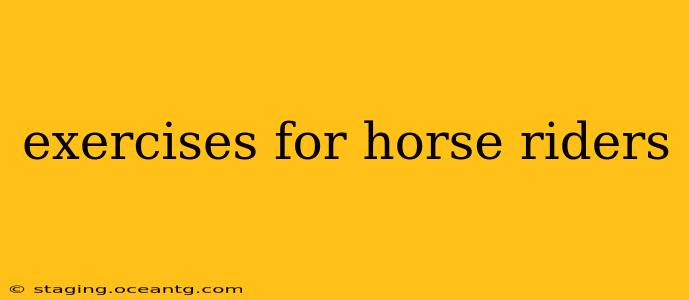Riding horses is a demanding sport, requiring strength, balance, flexibility, and core stability. Riders who neglect their own physical fitness often find themselves struggling with pain, fatigue, and ultimately, a less effective ride. This article outlines essential exercises for horse riders, addressing common weaknesses and improving overall performance in the saddle. We'll also address some frequently asked questions surrounding rider fitness.
Why is Fitness Important for Horse Riding?
Before we dive into the exercises, let's understand why physical fitness is crucial for horse riding. A strong, balanced rider is better able to:
- Maintain proper posture: Poor posture leads to discomfort, pain, and ineffective communication with the horse.
- Effectively use aids: Strong core muscles and balanced posture are essential for clear and subtle use of the reins, seat, and legs.
- Absorb the horse's movement: A fit rider can better absorb the horse's movement, providing a more stable and comfortable ride for both horse and rider.
- Prevent injuries: Strong muscles and good flexibility reduce the risk of injury to both rider and horse.
- Improve performance: A fit rider can ride for longer periods, maintain better form, and ultimately achieve a higher level of performance.
Exercises to Improve Rider Fitness
This section focuses on key areas often neglected by riders: core strength, lower body strength, and flexibility.
Core Strength Exercises:
- Plank: Hold a plank position (forearms on the ground, body in a straight line) for 30-60 seconds, repeating 3-5 times. This exercise strengthens your entire core.
- Side Plank: Similar to the plank, but on your side, supporting your body weight with one forearm and the side of your foot. Hold for 30-60 seconds per side, repeating 3-5 times. This targets your obliques, crucial for stability in the saddle.
- Bird-Dog: Start on your hands and knees. Extend one arm forward and the opposite leg backward, keeping your back straight. Hold for a few seconds, then repeat on the other side. This improves balance and core stability.
- Crunches: Traditional crunches are a great way to strengthen your abdominal muscles. Aim for 2-3 sets of 15-20 repetitions.
Lower Body Strength Exercises:
- Squats: Squats strengthen your quads, hamstrings, and glutes, all essential for maintaining balance and stability in the saddle. Aim for 2-3 sets of 15-20 repetitions.
- Lunges: Lunges improve balance and leg strength. Perform 2-3 sets of 10-12 repetitions per leg.
- Calf Raises: These strengthen your calf muscles, improving ankle stability and helping you maintain your stirrups. Aim for 2-3 sets of 15-20 repetitions.
Flexibility Exercises:
- Hamstring stretches: Tight hamstrings restrict your hip movement, impacting your seat and balance. Hold each hamstring stretch for 30 seconds, repeating 2-3 times.
- Hip flexor stretches: Tight hip flexors can lead to lower back pain. Hold each hip flexor stretch for 30 seconds, repeating 2-3 times.
- Shoulder stretches: Shoulder mobility is crucial for maintaining correct posture and using your arms effectively. Perform various shoulder stretches, holding each for 30 seconds, repeating 2-3 times.
What are the best exercises for improving balance for riding?
Improving balance for riding goes hand-in-hand with core and lower body strength. In addition to the exercises above, consider adding:
- Single-leg stances: Practice standing on one leg for increasing durations, focusing on maintaining balance.
- Balance board exercises: Balance boards challenge your stability and improve your proprioception (body awareness).
- Yoga and Pilates: These disciplines focus on building core strength, balance, and flexibility.
What exercises improve my core strength for riding?
As mentioned previously, planks (standard and side), bird-dogs, and crunches are excellent for core strength. It's also important to focus on exercises that engage the deep core muscles, such as pelvic tilts and hollow body holds. These are crucial for maintaining stable posture in the saddle.
How can I improve my posture while riding?
Improving posture is a multifaceted approach involving both physical conditioning and mindful riding practices. The exercises listed above will help strengthen the muscles needed for good posture. In addition, consider seeking professional instruction from an experienced riding instructor who can help you identify and correct postural issues. They can provide feedback on your position and guide you on how to maintain correct posture while riding.
Conclusion
Implementing a regular exercise routine tailored to the demands of horse riding can significantly enhance your performance, comfort, and safety in the saddle. Remember to consult your doctor or physical therapist before starting any new exercise program. Consistent effort and mindful practice will lead to noticeable improvements in your riding ability and overall well-being.
